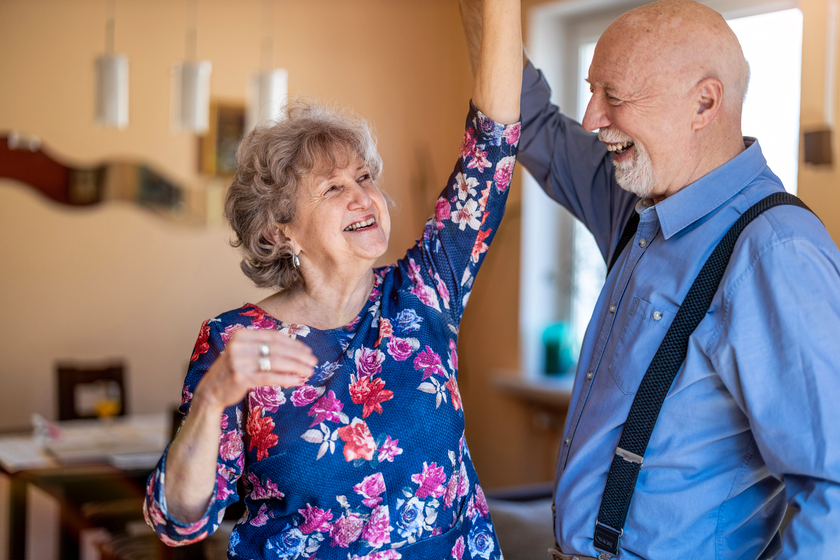As families and caregivers explore engaging activities for dementia patients, one particular activity shines brightly – dancing. Within retirement communities and even in the comfort of one’s home, dancing has emerged as an effective, enjoyable, and holistic approach to supporting those with dementia. The rhythmic movement, the familiar tunes, and the joy of shared moments make dancing not just an activity, but a therapy. Here’s a deeper look into why dancing holds a special place in the hearts of dementia patients and their caregivers.
Encouraging Physical Movement
The inherent beauty of dancing lies in its ability to seamlessly merge enjoyment with physical activity. For dementia patients, this synthesis becomes even more meaningful. At its core, dancing is about expressing oneself through motion, and this very motion is therapeutic in numerous ways.
Firstly, regular dancing aids in improving circulation throughout the body. As the heart rate gently increases with each sway and step, it ensures a robust flow of oxygenated blood to various organs, including the brain. This is paramount for dementia patients, as increased blood flow can enhance brain health and potentially slow cognitive decline.
Additionally, the varied movements involved in dancing – be it the stretching of arms, the gentle flexing of the legs, or the rhythmic sway of the hips – all contribute to muscle strength and flexibility. This not only enhances physical stamina but also aids in preventing potential injuries, ensuring that residents maintain their independence for longer.
Furthermore, in the cozy environment of a retirement community, dance sessions can be tailored to accommodate each resident’s physical capabilities. Movements can be modified, ensuring that everyone, irrespective of their physical condition, can partake in the joy of dancing. This adaptability ensures that dancing remains inclusive, therapeutic, and always centered on the well-being of the individual.
Stimulating Cognitive Function
Engaging in dance is more than just a physical exercise; it’s a cerebral experience as well. The inherent connection between music, rhythm, and movement taps into various cognitive domains, making it a potent activity for dementia patients to bolster their brain functions.
When residents dance, they engage multiple parts of their brain simultaneously. Remembering the steps to a particular tune, synchronizing movements with the rhythm, and even anticipating the next move all require cognitive processing. This active engagement can sharpen mental acuity, improve concentration, and boost memory recall. Such stimulation becomes especially valuable for dementia patients, as it offers them pockets of clarity and cognitive reinforcement amidst the fog of their condition.
Furthermore, dancing often comes with an auditory component—the music. Familiar melodies and tunes can trigger neural pathways associated with memory and recognition. For a dementia patient, recognizing an old favorite song and associating it with dance steps can be a profound moment of connection, where the past and the present beautifully converge.
In essence, dancing is a harmonious blend of physical movement and cognitive stimulation. In the realm of activities for dementia patients, it stands out as an enriching and beneficial pursuit that nurtures both the mind and body.
Evoking Emotions and Memories
There’s something incredibly nostalgic about music and dance. A familiar tune from one’s youth can transport a dementia patient back to a cherished memory, evoking emotions and sentiments from the past. Dancing provides an avenue for these memories to resurface, allowing residents to reconnect with their past and share stories with their loved ones and caregivers.
Social Interaction and Connection
Dancing is, by its very nature, a communal activity. Whether it’s a group dance session in the retirement community or a one-on-one dance with a family member, it promotes social interaction. For dementia patients, this means an opportunity to connect, communicate, and share joyous moments. This interaction can alleviate feelings of loneliness and isolation, which are common in dementia patients, fostering a sense of belonging.
Aiding Emotional Well-being
The joy of dancing is palpable. The sheer act of moving to music, expressing oneself without the confines of language, can uplift one’s spirits. For dementia patients, this translates to moments of happiness, laughter, and emotional release. It’s a holistic therapy that not only caters to the mind and body but also to the heart and soul.
Versatility of Dance
One of the reasons why dancing is such an effective activity for dementia patients is its versatility. It’s not confined to a specific genre or style. Be it ballroom, salsa, folk, or even just freestyle – each form offers its therapeutic touch. Depending on the preferences and cultural background of the resident, the community team can curate dance sessions that resonate most with the individual, making it personalized and even more effective.
In the world of therapeutic activities for dementia patients, dancing emerges as a beacon of hope, joy, and healing. It transcends the usual boundaries of communication, offering residents a medium to express, remember, and connect. As retirement communities and caregivers globally recognize its potential, dancing continues to weave stories of love, nostalgia, and happiness, one step at a time.







